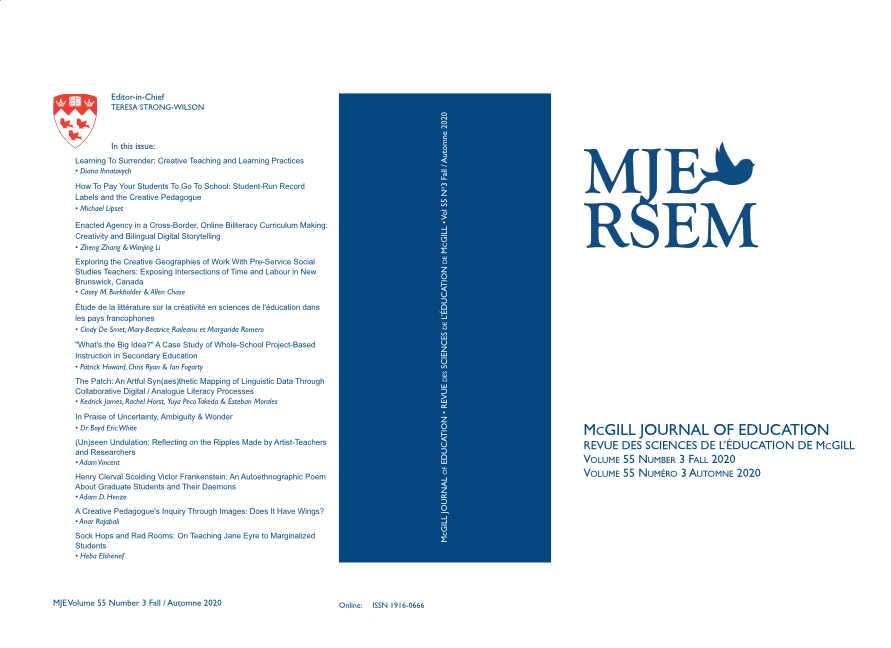Apprendre la reddition : pratiques d’enseignement et d’apprentissage créatifs
Mots-clés :
interprétation au piano, expression créative, formation des enseignants, pédagogie musicale, improvisationRésumé
L’indépendance et la pensée critique sont cruciales pour la survie dans notre monde contemporain. Il faut avoir confiance que les apprenants et les nouveaux enseignants découvriront et développeront leur propre voix en enseignement et en apprentissage et qu’ils seront encouragés à abandonner l’attente de produire des résultats prédéterminés en suivant strictement le programme d’études, qui ne favorise pas l’autonomie et l’esprit critique. En nous engageant dans des pratiques d’enseignement et d’apprentissage créatives qui encouragent l’imagination, le questionnement, l’observation et la réflexion, nous pouvons voir au-delà du normal et compréhensible. Nous pourrons alors découvrir de nouvelles façons d’interpréter la réalité et de vivre le quotidien ainsi qu’apprendre à écouter à nos étudiants et les accompagner dans leurs propres découvertes.
Références
Altass, P., & Wiebe, S. (2017). Obsolete ideologies for the knowledge based creative economy: Essential next steps for innovative classroom practices. Teaching and Learning, 11(1), 32-46. https://doi.org/10.26522/tl.v11i1.437
Ashton, W., & Denton, D. (2006). Introduction: Spirituality, ethnography and teaching. In W. Ashton & D. Denton (Eds.), Spirituality, ethnography, and teaching: Stories from within (pp. 1-14). Peter Lang Inc.
Bloom, L.A., & Dole, S. (2018). Creativity in education: A global concern. Global Education Review 5(1), 1-4.
Bloom, M., & Gullotta, T. P. (2001). Creativity and primary prevention: Terms of engagement. In M. Bloom & T.P. Gullotta (Eds.), Promoting creativity across the life span. (pp. 1–16). CWLA Press.
Denzin, N. K. (2013). Interpretive autoethnography. In S.L. Holman Jones, T.E. Adams, & C. Ellis (Eds.), Handbook of autoethnography (pp. 123-142). Left Coast Press, Inc.
DeZutter, S. (2011). Professional improvisation and teacher education: Opening the conversation. In R. Sawyer (Ed.), Structure and improvisation in creative teaching (pp. 27-50). Cambridge University Press.
Eisner, E. W. (2002). The arts and the creation of mind. Yale University Press.
Ellis, C. (2009). Revision: Autoethnographic reflections on life and work. Left Coast Press, Inc.
Freire, P. (2008). Pedagogy of the oppressed. Continuum.
Gouzouasis, P., & Ryu, J. Y. (2015). A pedagogical tale from the piano studio: Autoethnography in early childhood music education research. Music Education Research, 17(4), 397-420. https://doi.org/10.1080/14613808.2014.972924
Green, L. (2008). Music, informal learning and the school: A new classroom pedagogy. Ashgate Publishing.
Greene, M. (1995). Releasing the imagination: Essays on education, the arts, and social change. Jossey-Bass Publishers.
Howard, P., Becker, C., Wiebe, S., Carter, M., Gouzouasis, P., McClarnon, M., Richardson, P., Ricketts, K., & Schuman, L. (2018). Creativity and pedagogical innovation: Exploring teachers' experiences of risk-taking. Journal of Curriculum Studies, 50(6), 850-864. https://doi.org/10.1080/00220272.2018.1479451
Jones, S. L., Adams, T.E., & Ellis, C. (2013). Introduction: Coming to know autoethnography as more than a method. In S. L. Jones, T. E. Adams, & C. Ellis (Eds.), Handbook of autoethnography (pp. 17-47). Left Coast Press, Inc.
Meisner, S., & Longwell, D. (1987). Sanford Meisner on acting (1st ed.). Vintage Books.
Meyer, K. (2006). Living inquiry: A gateless gate and a beach. In W. Ashton & D. Denton (Eds.), Spirituality, ethnography and teaching: Stories from within (pp. 156–166). Peter Lang.
Meyer, K. (2010). Living inquiry: Me, myself and other. Journal of Curriculum Theorizing, 26(1), 85-96.
Nachmanovitch, S. (1990). Free play: Improvisation in life and art. Jeremy P. Tarcher.
Nussbaum, M. C. (2011). Creating capabilities: The human development approach. Harvard University Press.
Paynter, J., & Aston, P. (1970). Sound and silence: Classroom projects in creative music. Cambridge.
Pinar, W. F. (2004). A lingering note: An introduction to the collected works of Ted Aoki. In W. F. Pinar & R. L. Irwin (Eds.), Curriculum in a new key: The collected works of Ted Aoki (pp. 1-89). Lawrence Erlbaum.
Wiebe, S., Gouzouasis, P., Howard, P., McLarnon, M., Ricketts, K., & Shuman, L. (2018). Teaching creativity, creatively teaching: Exploring the arts and design thinking in education. Special capsule issue, Canadian Journal of Education, 41(1), i-vii.
Zhao, Y. (2012). World class learners: Educating creative and entrepreneurial students. Corwin Press.
Téléchargements
Publié-e
Comment citer
Numéro
Rubrique
Licence
(c) Tous droits réservés McGill Journal of Education / Revue des sciences de l'éducation de McGill 2021

Cette œuvre est sous licence Creative Commons Attribution - Pas d'Utilisation Commerciale - Pas de Modification 4.0 International.



